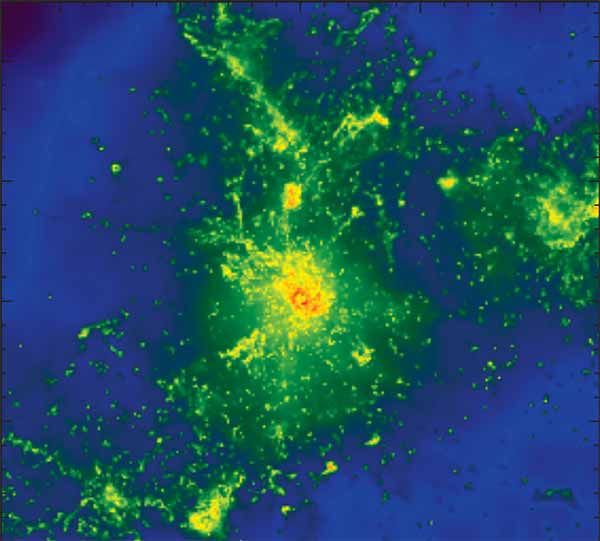New Simulation Illuminates Origin of the Brightest Galaxies
Published Date
By:
- Susan Brown
Share This:
Article Content

Multiple spots in a simulated galaxy glow brightly at submillimeter wavelengths of light.
A simulation that traced the evolution of enormous, bright galaxies over the course of several billion years has illuminated the possible origins of some of the most extreme objects in the universe.
Large smudges glowing with heat deep in space have intrigued astronomers since first glimpsed in the late 1990s. Called “submillimeter galaxies” for the wavelengths of their light we detect, they are colossal in size and igniting new stars at astonishing rates, a thousand times faster than our own galaxy. But submillimeter galaxies are so filled with dust that almost no starlight reaches us. Instead telescopes detect only the glow of dust heated by immense stellar radiation.
Collisions between galaxies that compress gas to form many new stars account for the brightest galaxies nearby, but those starburst events are brief in astronomical time. Whether the extreme starbirth within submillimeter galaxies also resulted from collisions has been unresolved.
Simulations that model how galaxies form—based on the physical laws of nature—provide a way to understand the how the universe, including galaxies like these, evolved. Earlier efforts to model submillimeter galaxies either failed to generate end states that match what astronomers actually see or needed to make extreme assumptions about the underlying physical processes, such as unrealistic masses of formed stars, to force a match.
The new simulation, published this week by Nature, is based on more realistic and complete physics, including the energy input of stars to their surrounding gas. It also accounts for the transfer of energy from starlight to heated dust to better estimate how brightly the galaxy glow with long-wavelength light. When played out for several billion years—computations that ran for weeks even on supercomputers with large numbers of computing cores—the simulation generated galaxies that resemble astronomical observations.
The team found that no large mergers were needed to create submillimeter-bright galaxies, just large galaxies with great amounts of gas within a massive halo of dark matter.
“Traditionally these galaxies were explained as major mergers of galaxies, but we find that in this more realistic simulation, they are just really big galaxies bombarded by smaller ones and eating the gas from their surroundings at all times. That supplies this huge star formation,” said Dušan Kereš, an assistant professor of physics and member of the Center for Astrophysics and Space Sciences at UC San Diego, and one of the co-authors of the new study. Keres generates astrophysical models with a particular focus on cycles of star formation and the ways galaxies gain gas and lose or reuse materials from spent stars.
When the team spun their initial conditions forward using their improved code for modeling physics and included the radiative transfer of energy from stars to dust, the simulated galaxies began to glow with submillimeter radiation. And the galaxies persist in their intense starmaking state for a long time. “You can have a submillimeter-bright phase that lasts a signifiant fraction of their lifetimes, hundreds of millions or even a billion years,” Kereš said.
The simulation creates a view of these galaxies at far more precise scales than they have been observed so far. The resolution of submillimeter wavelenghts by older telescopes was insufficient to register more than a smear of light.
“With the model, we can start resolving some of the details of those submillimeter galaxies,” Kereš said. “We can see there are multiple objects, sometimes three, four of five separate objects, within the ‘beam’ of earlier images.”
Newer observatories, particularly with ALMA, an array of 66 dishes high the Chilean Andes, will allow astronomers to see greater detail, which will allow them to determine how well distant submillimeter-bright galaxies match galaxies created in this simulation.
Authors of the report include Desika Narayanan of Haverford College and eight others from additional institutions. Keres’s work is supported by the National Science Foundation. NSF, NASA, the Gordon and Betty Moore Foundation and the Alfred Sloan Foundation also provided funding for the project.
Share This:
Stay in the Know
Keep up with all the latest from UC San Diego. Subscribe to the newsletter today.



